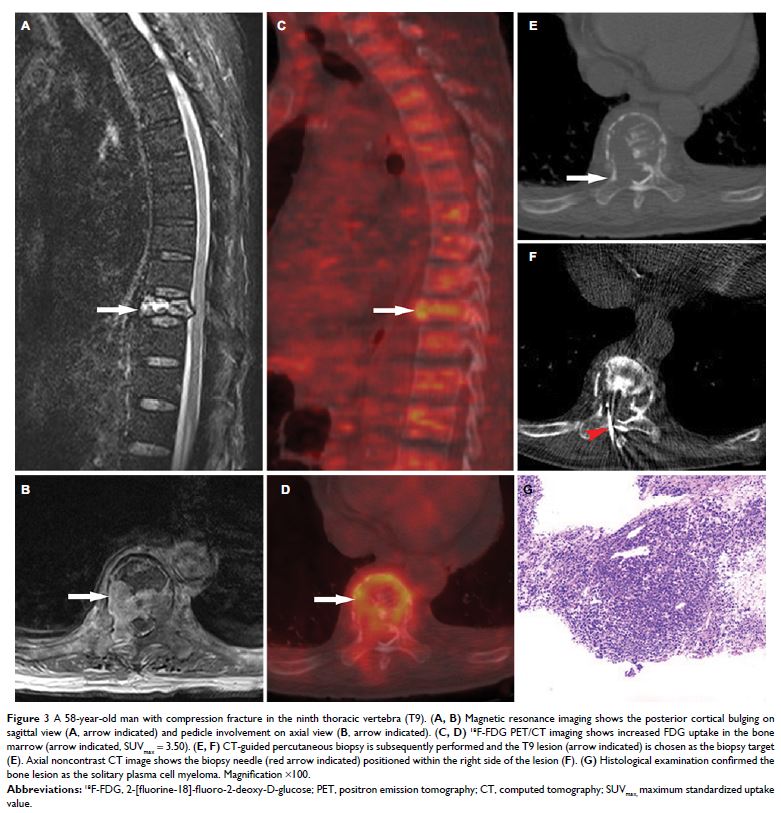9 0 8 0 2
论文已发表
注册即可获取德孚的最新动态
IF 收录期刊
- 2.6 Breast Cancer (Dove Med Press)
- 3.9 Clin Epidemiol
- 3.3 Cancer Manag Res
- 3.9 Infect Drug Resist
- 3.6 Clin Interv Aging
- 4.8 Drug Des Dev Ther
- 2.8 Int J Chronic Obstr
- 8.0 Int J Nanomed
- 2.3 Int J Women's Health
- 3.2 Neuropsych Dis Treat
- 4.0 OncoTargets Ther
- 2.2 Patient Prefer Adher
- 2.8 Ther Clin Risk Manag
- 2.7 J Pain Res
- 3.3 Diabet Metab Synd Ob
- 4.3 Psychol Res Behav Ma
- 3.4 Nat Sci Sleep
- 1.9 Pharmgenomics Pers Med
- 3.5 Risk Manag Healthc Policy
- 4.5 J Inflamm Res
- 2.3 Int J Gen Med
- 4.1 J Hepatocell Carcinoma
- 3.2 J Asthma Allergy
- 2.3 Clin Cosmet Investig Dermatol
- 3.3 J Multidiscip Healthc

18F-FDG PET/CT 对良、恶性椎体压缩骨折的鉴别诊断价值:与磁共振成像比较
Authors He X, Zhao L, Guo X, Zhao L, Wu J, Huang J, Sun L, Xie C, Chen H
Received 16 March 2018
Accepted for publication 14 May 2018
Published 18 July 2018 Volume 2018:10 Pages 2105—2115
DOI https://doi.org/10.2147/CMAR.S168374
Checked for plagiarism Yes
Review by Single-blind
Peer reviewers approved by Dr Cristina Weinberg
Peer reviewer comments 3
Editor who approved publication: Professor Luzhe Sun
Purpose: The purpose of this study was to evaluate the differential
diagnostic value of 2-[fluorine-18]-fluoro-2-deoxy-D-glucose (18F-FDG) positron emission tomography (PET)/computed tomography (CT) for
benign and malignant vertebral compression fractures (VCFs), where the
diagnostic accuracy of 18F-FDG PET/CT was compared with magnetic resonance imaging (MRI).
Patients and
methods: Between 2015 and 2017, we
retrospectively evaluated 87 patients with 116 VCFs. MRI was performed in all
the 87 patients, whereas 18F-FDG PET/CT was executed in 51 patients. Three malignant features
(convex posterior cortex, epidural mass formation, and pedicle enhancement)
from MRI and the maximum standardized uptake value (SUVmax) from 18F-FDG PET/CT were evaluated in benign and malignant VCFs, respectively.
Sensitivity, specificity, positive predictive value, and negative predictive
value of MRI and 18F-FDG PET/CT were compared in the differentiation of malignant from
benign VCFs.
Results: The results of our investigation showed that the sensitivity and
specificity for predicting malignant VCFs were 75.6% and 77.3% for convex
posterior cortex, 82.9% and 813% for epidural mass formation, and 85.7% and
70.8% for pedicle enhancement. 18F-FDG PET/CT demonstrated higher sensitivity (100%) but lower
specificity (38.9%) as compared to MRI with regard to differentiation between
benign and malignant VCFs. A significant difference in the SUVmax values was observed between the benign and malignant fractures
(2.9 ± 1.0 vs 5.0 ± 1.8, P < 0.01).
Besides the value of SUVmax, it has been noticed that the FDG uptake pattern differed in malignant
and benign fractures.
Conclusion: Significant MRI findings such as convex posterior cortex, epidural
mass formation, and pedicle enhancement are highly suggestive of
malignancy. 18F-FDG PET/CT reliably differentiated the fractures of malignant from
benign based on both SUVmax and 18F-FDG uptake pattern. In a situation where MRI findings are not
diagnostic, 18F-FDG PET/CT provides additional information as it has high sensitivity
and is semiquantitative.
Keywords: vertebral compression fractures, MRI, 18F-FDG PET/CT, maximum standardized uptake value
